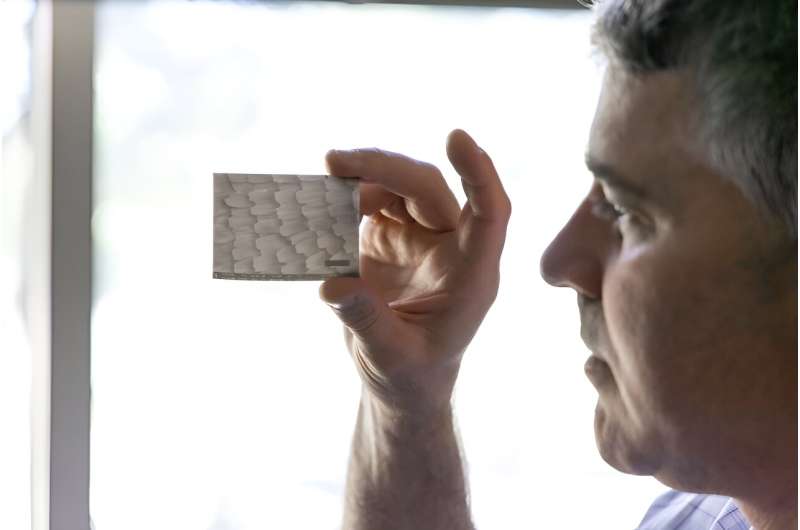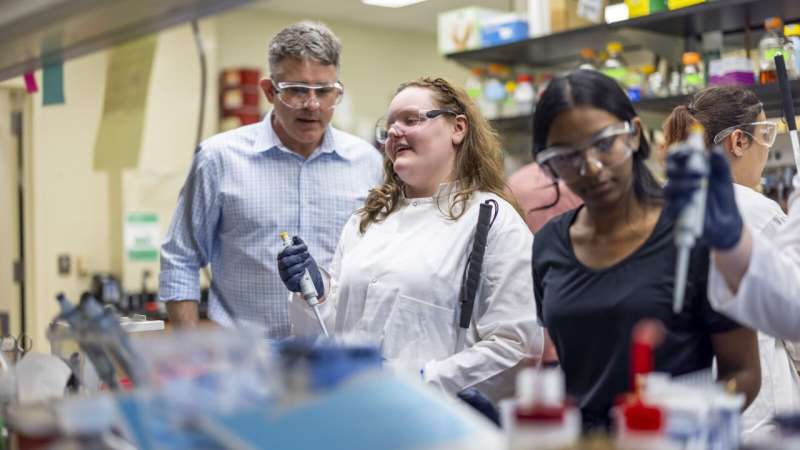This article has been reviewed according to Science X's editorial process and policies. Editors have highlighted the following attributes while ensuring the content's credibility:
fact-checked
peer-reviewed publication
trusted source
proofread
Tactile lithophane development makes hard scientific data available to students with blindness

A first-of-its-kind tactile learning device developed by Baylor University chemistry professors to make science accessible to students with blindness or low vision (BLV) has opened the possibility of the transfer of any scientific data or images for sighted students into functional, thorough formats for students with blindness. The work is published in the journal Science Advances.
The latest research from Bryan F. Shaw, Ph.D., professor of chemistry and biochemistry at Baylor, focused on the development of a codex using lithophane—an ancient art form—to convert images from scientific textbooks into tactile formats for students with BLV. The study, in collaboration with John L. Wood, Ph.D., The Robert A. Welch Distinguished Professor of Chemistry at Baylor, documents experiences from students with the Texas School for the Blind and Visually Impaired (TSBVI), who have partnered with Shaw on a variety of in-person learning opportunities and research projects.
"This is the first example that we know of in which blind high school students are able to visualize nanoscopic and microscopic imagery with tactile sensing at the exact same resolution as their sighted peers," Shaw said. "That's the focus of this paper—getting materials in the hands of high schoolers and seeing the results."
The study, which incorporated students from TSBVI, demonstrated that students with blindness or low vision could accurately describe, recall and distinguish high-resolution data and imagery at an average accuracy of 88%—comparable to sighted peers.
For Shaw, a burgeoning research focus on science accessibility stems from experiences with his 15-year-old son, Noah, who was diagnosed as an infant with retinoblastoma, an aggressive pediatric eye cancer. Today, Noah is thriving despite losing one eye and having limited vision in his remaining eye, and Shaw has developed a mix of approaches to make science data and science labs accessible to those with blindness and low vision. Shaw's latest paper is his fourth in Science Advances.
Tactile sensing through ancient medium
TSBVI students were able to visualize this data through the use of lithophanes. Likely created in China as early as the seventh century and popularized in Europe in the 1800s, lithophanes are thin engravings made from translucent materials, now 3D-printed with raised imagery suitable for tactile learning. Through use of lithophanes, students with blindness can feel what their sighted counterparts can see. The study suggests that beginning students can visualize, comprehend and discern high-resolution nanoscopic or microscopic images as well as a sighted person.
A 2022 proof-of-concept study in Science Advances highlighted the efficacy of lithophanes. The study found that the average test accuracy for all five lithophanes was:
- 96.7% for tactile interpretation by blind adults,
- 92.2% for sighted interpretation of back-lit lithophanes, and
- 79.8% for tactile interpretation by blindfolded students with normal eyesight.
Sighted participants were able to accurately interpret digital images on a computer screen at 88.4% by eyesight. For 80% of questions, the blind chemists' tactile accuracy was equal or superior to visual interpretation of lithophanes, suggesting that lithophanes could function as a shareable data format. In fact, Shaw said some of the blind chemists in the study has such tactile sensitivity that they could feel tactile features of the data that sighted individuals could barely see themselves.
The latest study followed TSBVI students in their ability to visualize changes in images from high-resolution, nanoscopic and microscopic images through touch. The students involved in the study were provided their first high-resolution tactile codex (or book) of real-life microscopic and nanoscopic imagery, which also can be found in science books for sighted students.
"Lithophane codexes are just that simple—lithophane books," Shaw said. "But this is the first example of a lithophane book that we know of and the first time it's been put in the hands of high-school students."
For example, students used a tactile codex of a butterfly at various degrees of magnification in an electron microscope. Using the image of a butterfly as the base, students could go deeper into the inner workings of the insect. They started with the shape of a butterfly, which many of the students had never felt.
From there, students felt a butterfly wing image as viewed through a microscope, with fish scale-like images making the intricacy of the butterfly's wing accessible. Magnified even higher through a microscope, a third image featured a single scale, with the final image showing the chemical structures that comprise the scaled wings of a butterfly.

Students were tested for their understanding of the layers of scales and cells on each lithophane, with students demonstrating mastery of the images through touch.
"When you develop a new drug, you do all the science to create a drug, but when you give it to a person and it works, that testing period is over," Shaw said. "That's what we have here through these images and the lithophane codex."
The study also brought students from TSBVI into research labs at Baylor and introduced them to universal chemical graphics. These graphics allowed students to feel the structures of molecules that were reactants and products in chemical reactions. In real time, students felt different structures of molecules as the molecules were reacted in front of them by graduate students with the Baylor Synthesis and Drug-Lead Discovery Lab, co-directed by Wood.
Equality and accessibility
To help educators who serve these students, Shaw's team developed an equation to determine how many pages a codex could accommodate based on the diameter of the binding. As an example, the 1,000 images found in a standard biochemistry textbook would need four lithophane books measured at 10 centimeters in width.
"Lithophanes make the high-resolution, serious scientific data 100% accessible to students with blindness. They won't be missing out on anything," Shaw said. That's what is beautiful about this. It's equality and equivalence. We can sit around with sighted and non-sighted people and talk about the exact piece of data, and it's beautiful."
Students with blindness and low vision (BLV) have long faced barriers to the study and discipline of chemistry, often due to the long-standing inaccessibility of science labs to people with disabilities, a lack of non-visual educational materials, and technologies not yet optimized for those with visual impairments. Shaw's laboratory will continue to focus on methods to eradicate those barriers for students with blindness and other disabilities in the future.
"It is critical to show students in high school and even earlier that they belong in science—it is open to them if they want to join—regardless of their diverse abilities, or so-called disability," Shaw said. "When I think about my son or other children with disabilities, what they do in their 30s and 40s depends on what we do for them now. And many scientists are too busy for that. But at Baylor, it's not that way. There's an ethos here."
More information: Emily A. Alonzo et al, Universal pictures: A lithophane codex helps teenagers with blindness visualize nanoscopic systems, Science Advances (2024). DOI: 10.1126/sciadv.adj8099




















